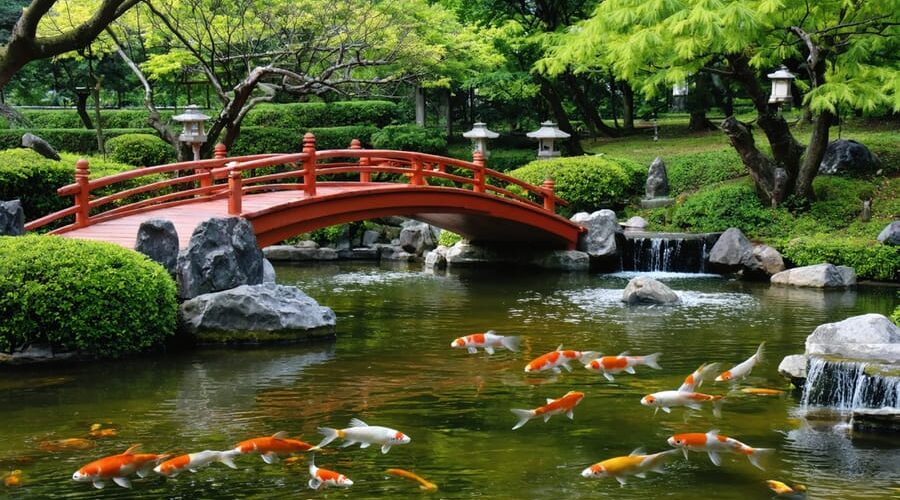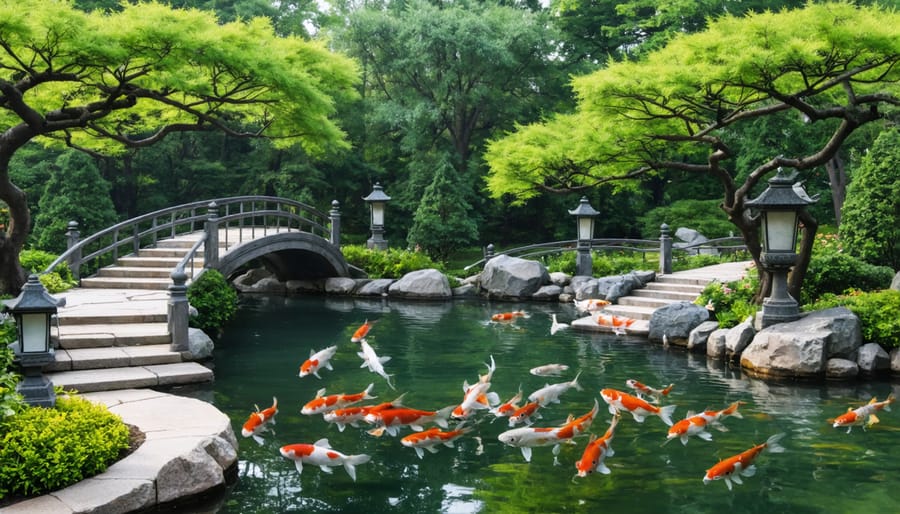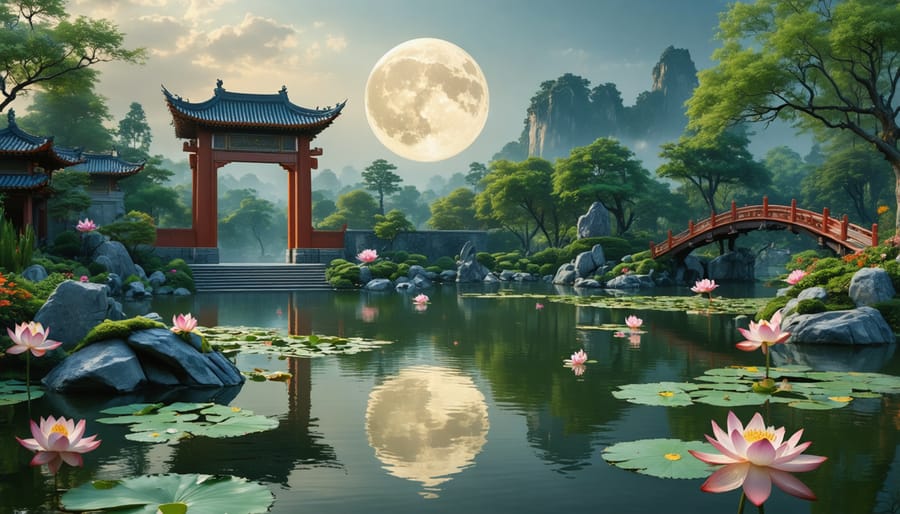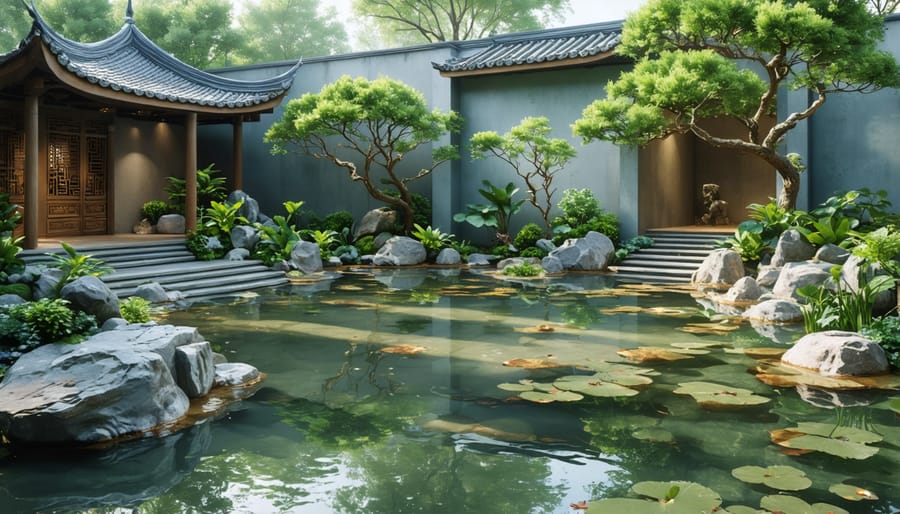
How Japanese Pond Design Transformed Modern Water Gardens
Across centuries and continents, pond culture has evolved into a mesmerizing fusion of art, nature, and cultural expression. From the serene koi ponds of Japanese gardens to the romantic water features of European estates, these aquatic sanctuaries reflect humanity’s enduring desire to capture the essence of natural beauty in controlled environments. Today’s pond culture transcends mere decoration, embodying ancient wisdom about harmony, balance, and the therapeutic power of water.
Modern pond enthusiasts draw inspiration from diverse cultural traditions, creating unique spaces that blend time-honored design principles with contemporary sustainability practices. Whether it’s the minimalist aesthetic of Zen gardens or the lush, naturalistic approach of English water gardens, each style tells a story of its cultural origins while offering practical solutions for modern outdoor spaces.
As we explore the rich tapestry of pond culture, we discover how different societies have developed distinct approaches to water feature design, each contributing valuable insights to the global language of garden aesthetics. These cultural influences not only shape the physical appearance of ponds but also inform our understanding of their role in creating meaningful outdoor spaces that nurture both body and spirit.
The Art of Japanese Pond Design
Zen Philosophy in Water Gardens
Zen philosophy brings a unique sense of peace and mindfulness to water garden design, reflecting the deep connection between nature and human consciousness. In Japanese pond gardens, every element serves a purpose beyond mere aesthetics – it’s about creating harmony and encouraging meditation.
The core principle of “ma” (negative space) guides the placement of rocks, plants, and water features. Just as important as what you add to your pond is what you leave empty, allowing the mind to rest and contemplate. Think of your pond as a living meditation space rather than just a water feature.
Water itself plays a central role, representing the flow of life and constant change. The gentle sound of moving water, whether from a small cascade or a bamboo fountain, helps create the perfect environment for reflection. Even the ripples on the water’s surface serve as a reminder of life’s impermanence – a key concept in Zen philosophy.
Traditional Japanese pond gardens often incorporate carefully positioned stones, representing mountains or islands, and meticulously pruned trees that appear to have been shaped by nature rather than human hands. These elements work together to create a miniature landscape that captures the essence of the natural world.
When designing your own Zen-inspired pond, remember that simplicity is key. Choose elements thoughtfully and avoid overcrowding. The goal is to create a space that feels both natural and intentional, where every component contributes to a sense of tranquility and balance.
Essential Elements of Japanese Ponds
Japanese ponds embody a deep connection between nature and human artistry, featuring carefully balanced elements that create a sense of tranquility and purpose. At the heart of Japanese pond design lies the concept of “miegakure” or “hide and reveal,” where winding paths and strategic placement of sculptural elements in water gardens create an engaging journey of discovery.
Water plays a central role, symbolizing the flow of life and purity. Traditional Japanese ponds often incorporate islands, representing mythical lands or sacred spaces, connected by graceful bridges that invite contemplation. Koi fish, when present, add vibrant movement and are considered living jewels that bring good fortune.
Key features include carefully positioned rocks, which represent mountains and provide natural-looking edges. These are often arranged in groups of three, following the principle of asymmetrical balance. Native plants like Japanese maples, iris, and moss create seasonal interest while maintaining a natural appearance.
Lanterns, whether stone or wooden, serve both practical and aesthetic purposes, casting gentle light on the water’s surface at dusk. The sound element is equally important, with small waterfalls or bamboo water features creating gentle, soothing sounds that mask urban noise and enhance the meditation-friendly atmosphere.
Each element works together to create a miniature representation of nature, encouraging visitors to slow down and appreciate the beauty of imperfection and simplicity.

Chinese Influences on Pond Design
Feng Shui Principles in Water Gardens
Feng shui principles have long guided the art of water garden design in Chinese culture, bringing harmony and positive energy flow to outdoor spaces. In traditional feng shui, water represents wealth and abundance, making ponds particularly significant features in garden design.
The placement of your pond is crucial – ideally, it should be positioned in the north, east, or southeast areas of your garden. These directions are associated with career success, family prosperity, and wealth respectively. Avoid placing ponds in southern locations, as this creates an imbalance between water and the fire elements associated with that direction.
The shape of your pond matters too. Gentle curves and flowing lines are preferred over sharp angles, as they promote smooth energy flow. Many feng shui practitioners recommend kidney-shaped or figure-eight designs, which symbolize infinity and continuous prosperity.
Adding specific elements can enhance your pond’s feng shui properties. Black or dark-colored fish, especially koi, are considered lucky. An odd number of fish is recommended, with nine being particularly auspicious. Water plants should be balanced – too many can stagnate energy, while too few may not provide enough life force.
Consider incorporating a small waterfall or fountain, as moving water symbolizes active wealth circulation. However, ensure the water flows toward your home rather than away from it to attract prosperity rather than drain it.
Traditional Chinese Garden Elements
Traditional Chinese gardens embrace ponds as essential elements that represent harmony between humans and nature. These ponds typically feature graceful curved edges rather than geometric shapes, mimicking natural water bodies. Key elements include strategically placed rocks and boulders along the shoreline, which symbolize mountains and create visual interest while providing natural-looking transitions between water and land.
Water plants play vital roles in Chinese pond design, with lotus flowers being particularly significant as they represent purity and enlightenment. Koi fish, often found in these ponds, bring movement and life while symbolizing perseverance and good fortune. Surrounding the pond, you’ll find carefully positioned pavilions and bridges that offer different viewing perspectives and create peaceful spots for reflection.
Traditional Chinese gardens use the principle of borrowed scenery, where distant views become part of the garden’s composition. Ponds are often positioned to reflect nearby trees, buildings, or mountain views, effectively doubling their visual impact. Small islands or rock formations within the pond create depth and mystery, while weeping willows planted along the edges add graceful movement and provide shade.
These design elements work together to create a tranquil space that encourages contemplation and connects visitors with nature’s rhythms.

Modern Interpretations of Cultural Pond Design
Fusion Designs
Modern pond design has evolved into a beautiful fusion of cultural elements, creating unique and personalized outdoor spaces that tell stories from around the world. Japanese zen gardens blend seamlessly with European formal pools, while Chinese feng shui principles complement contemporary minimalist designs.
For a harmonious fusion design, consider incorporating elements like Chinese moon gates alongside English cottage-style plantings, or combining Mediterranean terra cotta features with Asian-inspired stone lanterns. The key is to find balance in these combinations, ensuring each element complements rather than competes with others.
Popular fusion approaches include mixing natural stone arrangements inspired by Japanese gardens with formal European fountain features, or blending the geometric patterns of Islamic garden design with the flowing lines of naturalistic wildlife ponds. Native plants can be artfully arranged alongside exotic species, creating a global botanical tapestry that still supports local ecosystems.
Lighting plays a crucial role in fusion designs, with traditional paper lanterns potentially paired with modern LED underwater illumination. Water features can combine the tranquil sounds of a Japanese bamboo fountain with the dramatic displays of Italian-style cascades.
When planning your fusion pond, focus on creating transition zones that help different cultural elements flow together naturally. Use consistent materials or repeating patterns to tie diverse elements together, ensuring your pond feels cohesive despite its multicultural inspiration.

Contemporary Adaptations
Today’s pond enthusiasts are reimagining traditional design elements with exciting new twists. Using modern pond design techniques, homeowners can blend centuries-old concepts with contemporary materials and technology.
LED lighting has revolutionized the way we illuminate water features, creating dramatic nighttime displays that traditional oil lamps could never achieve. Solar-powered systems make these installations more sustainable and cost-effective than ever before.
Natural filtration systems now incorporate cutting-edge bio-materials while maintaining the aesthetic appeal of traditional reed beds. Automated maintenance systems can regulate water quality and flow while preserving the peaceful atmosphere of ancient pond designs.
Contemporary materials like glass fiber-reinforced concrete allow for sleeker edges and more dynamic shapes while mimicking traditional stone work. Recycled glass aggregate adds sparkle to pathways, offering an eco-friendly alternative to traditional pebble walks.
3D-printed decorative elements enable pond owners to recreate intricate traditional sculptures and architectural details at a fraction of the cost. Smart technology integration allows for remote monitoring and control of water features through smartphone apps, making maintenance more convenient while preserving the pond’s tranquil appearance.
These modern adaptations honor historical design principles while making ponds more practical and sustainable for today’s lifestyle.
Creating Your Own Culturally-Inspired Pond
Plant Selection and Placement
In traditional pond culture, plant selection and placement play crucial roles in creating harmony and meaning. Taking inspiration from Japanese gardens, consider placing taller plants like bamboo or ornamental grasses at the northern edge to create a protective backdrop. Follow smart planting strategies by incorporating layers of vegetation at different heights and depths.
Water lilies, sacred in many Asian cultures, should occupy about 60% of the water surface, placed in clusters of odd numbers. Include marginal plants like iris and rushes along the edges, representing the connection between water and land. Choose plants that hold cultural significance – lotus for purity, willow for flexibility, and pine for longevity.
Remember to balance yang (upright, structural plants) with yin (flowing, spreading plants) elements. Create visual anchors with statement plants at key viewing points, and use ground covers to soften edges. For year-round interest, mix evergreen and deciduous species, considering their seasonal changes and symbolic meanings in various cultures.
Hardscape Elements
Traditional hardscape elements play a vital role in creating an authentic pond culture experience. Natural stone pathways and bridges serve both practical and aesthetic purposes, allowing visitors to interact with the water feature while maintaining its cultural integrity. Japanese-inspired gardens often incorporate carefully placed stepping stones (tobi-ishi) that encourage mindful walking and contemplation.
Rock arrangements are particularly significant, with large boulders acting as focal points and smaller stones creating natural-looking edges. Many pond enthusiasts choose to include traditional structures like pagodas, tea houses, or meditation pavilions near their water features. These buildings provide shelter and create opportunities for peaceful reflection.
Retaining walls, when needed, can be built using traditional materials like natural stone or bamboo. These not only serve a practical purpose but also add authentic character to the space. Decorative elements such as stone lanterns, water basins, and bamboo fountains can be strategically placed to enhance the cultural atmosphere while maintaining functionality.
For a modern twist, consider incorporating contemporary materials that complement traditional elements, such as weathered steel or polished concrete, while still respecting the overall cultural aesthetic.
Water Features and Movement
Water features and movement play a vital role in pond culture, reflecting centuries-old traditions from around the world. The gentle splash of a waterfall or the soothing ripple of a stream isn’t just pleasing to the eye – it’s deeply rooted in cultural practices that value the therapeutic effects of moving water. Many garden designers focus on water flow and sound design to create spaces that engage multiple senses.
Traditional Japanese gardens often incorporate shishi-odoshi (deer scarers) and cascading waterfalls to create rhythmic sounds that promote meditation. Chinese gardens typically feature meandering streams that symbolize life’s journey, while European designs tend to favor dramatic fountains that make bold statements. Modern pond enthusiasts can blend these cultural elements by adding small waterfalls, bubble rocks, or stream features that match their garden’s style.
The key is finding the right balance – too much water movement can overwhelm a space, while too little might leave the pond feeling stagnant. Start with subtle features and adjust based on how the sounds interact with your outdoor environment.
As we’ve explored throughout this article, pond design is far more than just digging a hole and filling it with water – it’s a rich tapestry of cultural traditions that spans centuries and continents. From the serene simplicity of Japanese Zen gardens to the bold symmetry of European formal ponds, each culture brings its unique perspective to water feature design.
These diverse approaches to pond creation offer us more than just aesthetic inspiration; they provide deeper insights into how different societies view their relationship with nature and find harmony in their outdoor spaces. By understanding and appreciating these cultural influences, we can create more meaningful and personally resonant water features in our own gardens.
Whether you’re drawn to the minimalist beauty of Asian design, the dramatic flair of Mediterranean fountains, or the natural charm of English cottage garden ponds, there’s a wealth of tradition to draw from. Don’t be afraid to mix elements from different cultures or adapt traditional designs to suit your space and style. The most successful pond designs often come from a thoughtful blend of cultural inspiration and personal preference.
We encourage you to explore these various traditions further and experiment with incorporating different cultural elements into your pond design. Remember, your pond can be more than just a water feature – it can be a reflection of the world’s rich cultural heritage right in your own backyard.
